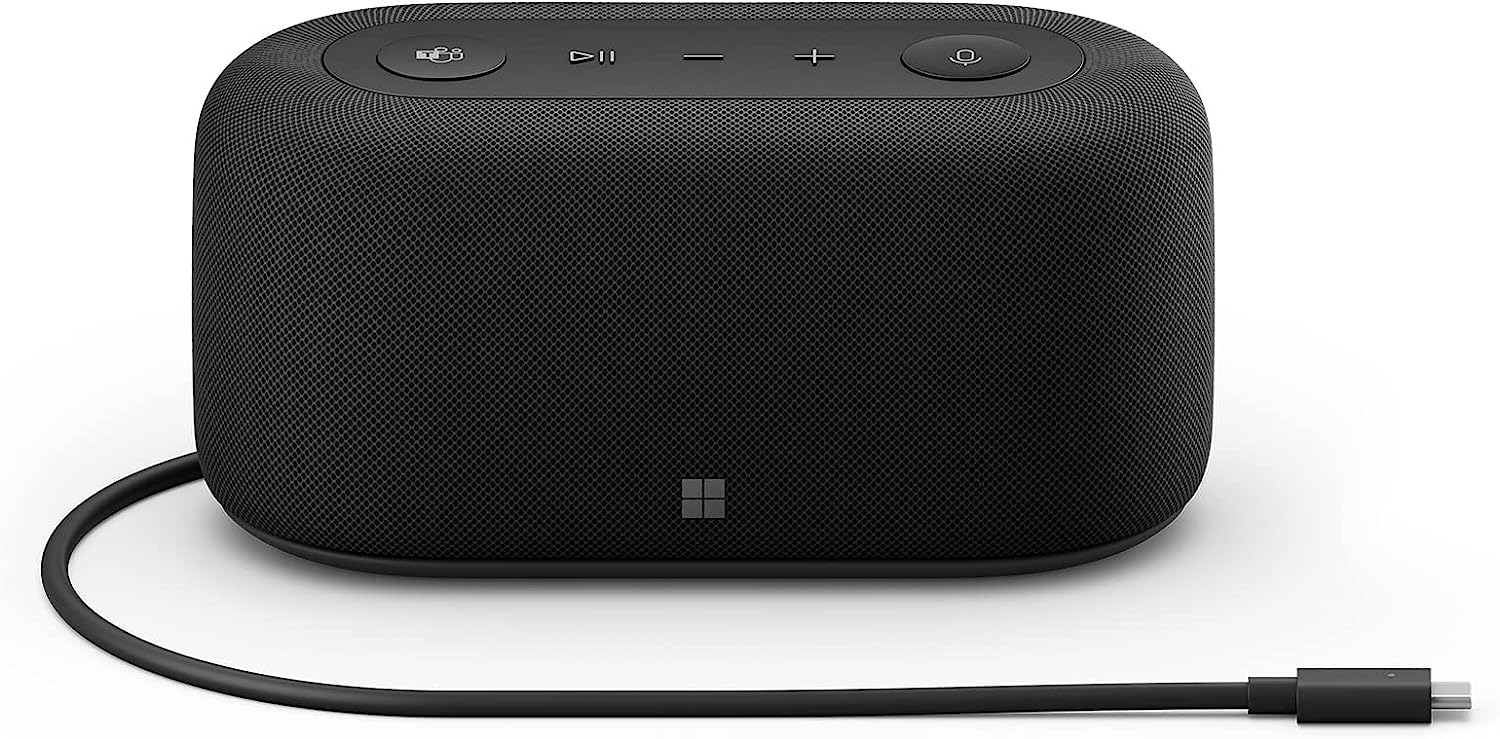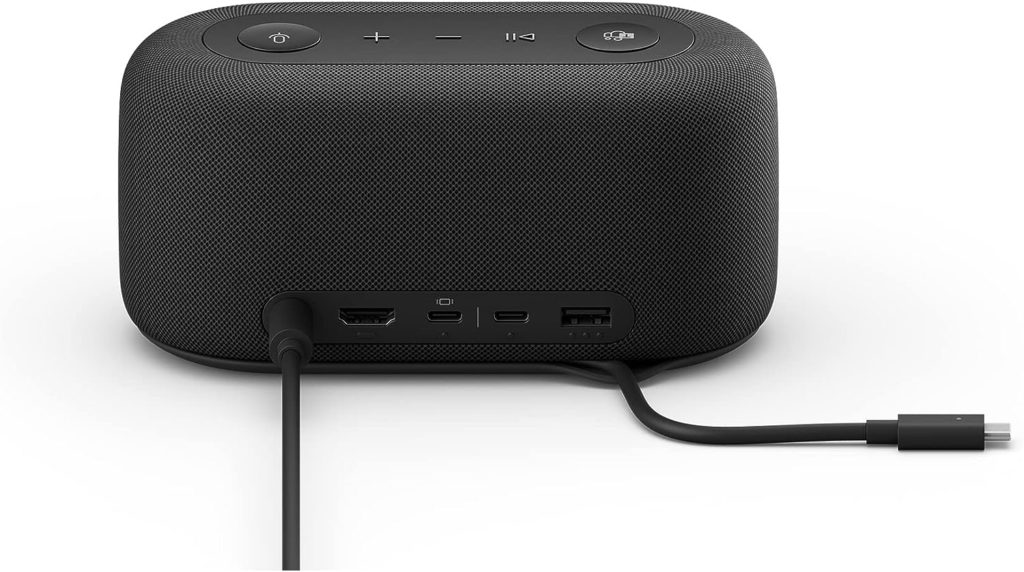*** TVReviewland.com earns commissions on qualifying purchases made through affiliate links ***
This Microsoft Audio Dock review finds out if this multi-purpose device is more suitable for work settings or personal, everyday use.
Microsoft’s Audio Dock is a conference speaker, device hub, power source, and occasional music player; all wrapped into one small gadget. We find out how well the audio dock handles each one of its roles.
Content Breakdown
Microsoft Audio Dock review: The concept behind the gadget
Microsoft positions the Audio Dock as a replacement for the Surface USB-C Dock, which is more of a device hub than anything else. The Audio Dock’s assignment is to reduce cable clutter while supporting conference calls at a workstation or small office setup.
Gone are the high-bandwidth Thunderbolt ports that you get with the Surface Dock. Instead, you get a smaller device with fewer ports, a conference phone, and speakers that can handle a little music.
Shoppers who want more connectivity options and more charging power now have to buy a second alternative to the USB-C Surface Dock. They have to spend a few extra dollars for the Surface Thunderbolt 4 dock, which may be the subject of a different review.
For now, we check out the features, use cases, strengths, and weaknesses of the Microsoft Audio Dock.
First looks
The Audio Dock has a squat, compact frame with rounded edges and black mesh cloth at the front and sides. At a glance, the gadget looks like a large, black pill with buttons, ports, and a cord sticking out of the back.
Rubber covers protect the top and bottom surfaces of the device, where they guard against slippage and slight knocks. The rubber surfaces are a nice touch, but they come with one little annoyance: You may struggle to press the buttons at the top of the dock.
You’ll find a row of ports at the back of the device, along with a non-removable USB C cable that plugs into your laptop.
Microsoft Audio Dock review: How the Audio Dock performs as a device hub
Multi-purpose gadgets like Microsoft’s Audio Dock often come with tradeoffs. With the Audio Dock, you gain a capable conference phone at the expense of high-speed Thunderbolt ports. The Audio Dock also has fewer connectivity options than many laptop docks from competing brands. Here’s what the Microsoft’s hybrid dock has to offer:
1. One HDMI output port that supports 4K content at 60Hz
This port supports screens with refresh rates of up to 60Hz and will comfortably handle full HD displays and 4K panels.
2. One second-generation USB-C 3.1 port
This connection has a maximum throughput of 10Gbps when the rest of the ports are free of demanding devices. Here’s what these specifications mean for the end user:
- You can connect a 4K@60Hz monitor through this port
- There’s an option of switching to DP (display port) mode for monitors that have a USB-C port
- The 10 Gbps bandwidth reduces when you connect more devices to the dock
It’s safe to say that this is the most versatile port on the Microsoft Audio Dock, thanks to its bandwidth and its support for pass-through charging. Still, the port’s 10 Gbps bandwidth has some limitations.
[Read what others are saying about this device]
3. One second-generation USB-C 3.1 port (data only)
This port supports high-speed transfers to storage devices, media players, and other electronics that are not screens. The port has a downstream output power of 7.5W, which is enough to charge phones, tablets, and other small devices.
4. A USB-A port
Use this ‘legacy’ port to connect storage drives, mice, and any small device that needs charging.
The Microsoft Audio Dock will handle two displays, with some caveats
For starters, the Microsoft Audio Dock has an easier time handling one 4K@60Hz screen instead of two. Alternatively, you could connect a pair of screens with lower resolutions or lower frame rates. As an example, the dock will easily support a pair of 4K@30Hz screens or a pair of 1080p@60Hz displays.
Also, the second monitor has to be a newer model with support for the latest USB-C compression and transmission protocols. This means that older monitors and screens may not be a good fit as secondary screens.
Lastly, you’ll rarely get port speeds of 10Gbps when connecting multiple devices to the dock. The devices will split the bandwidth among themselves, based on whatever priority list that the dock’s firmware enforces.
Microsoft Audio Dock review: How the audio dock performs as a power source
The dock has power passthrough capability and 60 Watts’ worth of upstream charging power. This means that Microsoft’s audio dock will charge your laptop through the USB-C cable that’s hard-wired to the gadget. The dock will easily charge most Microsoft Surface devices, but it may struggle to charge larger, more powerful laptops.
Like most device hubs, the Microsoft audio dock will charge your mobile devices on its USB ports.
Microsoft Audio Dock review: How the audio dock performs as a conference phone
Two omnidirectional microphones will perfectly capture your voice, even at a distance of 10 feet. The microphones work together to render and transmit loud, clear, noise-free audio. Those on the other end of your connection will receive clear audio that’s free of static and background noise.
In the same vein, the speaker phone produces sounds that will fill a small conference room or home office. This makes the audio dock a great fit for remote workers, collaborating teams, and students who attend online classes.
It’s worth noting that the core function of the Audio Dock is to enhance the usability of Microsoft Teams. So go ahead and use the Teams button at the top of the dock to ‘raise your hand’ whenever you want to contribute during a team meeting or video call. You can also enjoy the crisp, clear audio of the Microsoft Audio dock with Zoom and Google Meet.
Microsoft Audio Dock review: How the audio dock performs as a music player
The audio dock remains in music mode until you start a call on Zoom, Google Meet, or Teams. At this point, the gadget will automatically switch to conference mode to enhance vocals while minimizing background noise.
As a music player, the Audio dock leverages a 15W driver and a 5W tweeter. The forward-firing driver renders lower and mid-range frequencies, while the tweeter takes care of high treble. Together, the driver and tweeter form a single channel that does a surprisingly good job of filling a room.
The sound output has little bass to speak of, which is what we expect from a small speaker. Mid-range frequencies are rich and full, with plenty of detail that stands out in a roomy sound stage. Treble frequencies are less distinct, for some reason.
From a listener’s perspective, the resulting blend will lack the punchy bass and attention-grabbing treble elements that add extra spice to music. Still, this small speaker will come through for you in a pinch.
Pros
- This is a plug-and-play device that’s easy to use
- Seamless integration with Microsoft Teams
- Wide soundstage
- Good sound quality for conference calls
- The device can connect your laptop to two screens at the same time
- Upstream charging power of 60W will work fine for many laptops
Cons
- Fewer connectivity options than most docks
- The dock has a non-removable USB-C cable that can be inconvenient
- The absence of Bluetooth connectivity is unfortunate
- The dock has a maximum power output of 60W, which limits how fast the device can charge your laptop
Verdict: A good fit for the user with a specific set of needs
Microsoft’s Audio Dock can handle a few pieces of equipment with moderate bandwidth demands. The dock could be an option for the person who makes regular use of Zoom, Google Meet, or Microsoft Teams. As a speaker phone, this audio dock is loud enough for a small conference room, work area, or home office. The device is good for work or collaboration with people on the other end of an internet connection.
However, shoppers who need a wider selection of high-speed ports should opt for a special-purpose laptop dock. This alternative is a better fit for users with heavy bandwidth needs and little interest in a conference phone.
This Microsoft Audio Dock review reveals a multi-purpose conference phone with some perks on the side. Click here to learn more about this device.
Read more:
Exploring the Hisense 50-Inch ULED U6HF Series Quantum Dot QLED 4K UHD Smart Fire TV
Hisense U6HF review: A Budget QLED TV with Many Strengths and Room for Growth
Old Dads Review: An In-Depth Look at Bill Burr’s Netflix Hit
Bose Solo Soundbar 2 Review: Clear, Detailed Sound on a Budget
MacBook M3 Pro Review: Apple’s In-house Processors Continue To Impress




